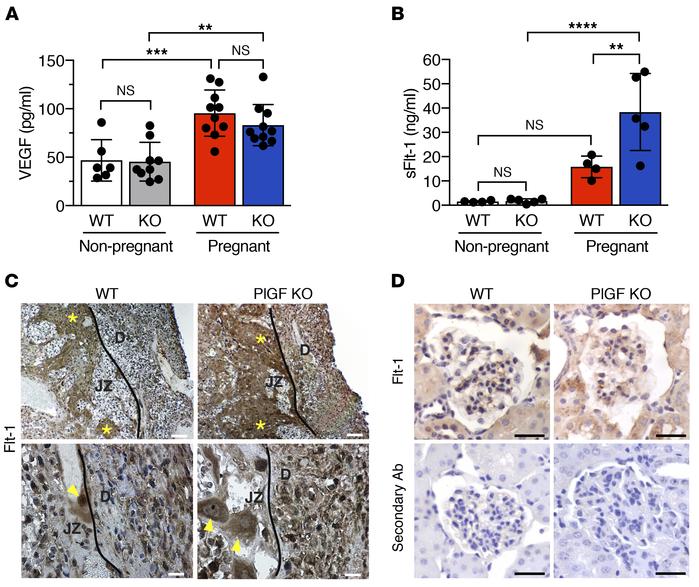Citation Information: J Clin Invest. 2018;128(11):5008-5017. https://doi.org/10.1172/JCI99026.
Abstract
Preeclampsia remains a clinical challenge due to its poorly understood pathogenesis. A prevailing notion is that increased placental production of soluble fms-like tyrosine kinase-1 (sFlt-1) causes the maternal syndrome by inhibiting proangiogenic placental growth factor (PlGF) and VEGF. However, the significance of PlGF suppression in preeclampsia is uncertain. To test whether preeclampsia results from the imbalance of angiogenic factors reflected by an abnormal sFlt-1/PlGF ratio, we studied PlGF KO (Pgf–/–) mice and noted that the mice did not develop signs or sequelae of preeclampsia despite a marked elevation in circulating sFLT-1. Notably, PlGF KO mice had morphologically distinct placentas, showing an accumulation of junctional zone glycogen. We next considered the role of placental PlGF in an established model of preeclampsia (pregnant catechol-O-methyltransferase–deficient [COMT-deficient] mice) by generating mice with deletions in both the Pgf and Comt genes. Deletion of placental PlGF in the context of COMT loss resulted in a reduction in maternal blood pressure and increased placental glycogen, indicating that loss of PlGF might be protective against the development of preeclampsia. These results identify a role for PlGF in placental development and support a complex model for the pathogenesis of preeclampsia beyond an angiogenic factor imbalance.
Authors
Jacqueline G. Parchem, Keizo Kanasaki, Megumi Kanasaki, Hikaru Sugimoto, Liang Xie, Yuki Hamano, Soo Bong Lee, Vincent H. Gattone, Samuel Parry, Jerome F. Strauss, Vesna D. Garovic, Thomas F. McElrath, Karen H. Lu, Baha M. Sibai, Valerie S. LeBleu, Peter Carmeliet, Raghu Kalluri
Figure 1
Elevation of serum sFlt-1 and placental Flt-1 levels in pregnant PlGF KO mice.



Copyright © 2025 American Society for Clinical Investigation
ISSN: 0021-9738 (print), 1558-8238 (online)

